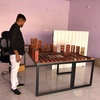When it comes to construction, the significance of solid bricks cannot be overstated. These timeless building materials have been an integral part of human civilization for centuries, offering unmatched durability, strength, and versatility. In this blog, we will delve into the rich history of solid bricks, their manufacturing process, and how they have evolved to become the cornerstone of modern building techniques. By understanding their attributes and benefits, we can appreciate why these unassuming blocks remain an essential choice in contemporary construction.
The Evolution of Solid Bricks: A Historical Perspective
The story of solid bricks dates back thousands of years to ancient civilizations like the Mesopotamians, Egyptians, and Indus Valley inhabitants. These early societies recognized the potential of fired clay bricks to construct durable structures that would stand the test of time. Over the centuries, various cultures adopted and improved the brick-making techniques, leading to the emergence of different types of bricks, each with unique characteristics.
Understanding Solid Bricks: Composition and Manufacturing
Solid bricks are primarily composed of clay, shale, or a mixture of both. The process of making solid bricks involves several steps, starting with the extraction of raw materials from clay pits or mines. After excavation, the clay is crushed, molded into brick shapes, and then subjected to high-temperature firing in kilns to increase their strength and durability.
During the firing process, the clay particles fuse together, forming a compact structure that gives the bricks their characteristic solidity. The final product is a versatile building material with consistent dimensions, making it easier for construction teams to work with.
The Advantages of Solid Bricks in Modern Construction
3.1. Exceptional Durability: Solid bricks have stood the test of time and have been proven to withstand harsh weather conditions and natural disasters better than many other building materials. Their resistance to fire, moisture, and pests ensures the longevity of structures built with these bricks.
3.2. Thermal Insulation: Solid bricks have excellent thermal insulating properties, regulating indoor temperatures by absorbing and slowly releasing heat. This leads to reduced energy consumption, making them an environmentally-friendly choice for sustainable construction.
3.3. Sound Insulation: Buildings constructed with solid bricks offer superior sound insulation, reducing noise transmission from the outside and between rooms. This quality contributes to enhanced comfort and privacy for the occupants.
3.4. Eco-Friendly Choice: Clay, the primary raw material for solid bricks, is abundant in nature and can be sourced sustainably. Additionally, the manufacturing process involves less energy consumption compared to other construction materials, making solid bricks a greener choice for eco-conscious builders.
3.5. Aesthetics and Versatility: Solid bricks come in various textures, colors, and sizes, allowing architects and builders to create visually appealing structures. They can be used for both load-bearing and non-load-bearing walls, facades, arches, and decorative elements, providing ample design possibilities.
Also Read: traditional brick - Bricks Street
Modern Building Techniques Incorporating Solid Bricks
4.1. Load-Bearing Structures: Solid bricks are widely used in load-bearing walls, where their compressive strength allows them to bear the vertical loads of the building. This construction technique is popular in residential, commercial, and industrial projects, ensuring structural integrity.
4.2. Reinforced Brick Masonry: To enhance the tensile strength of brick structures, engineers often use reinforced brick masonry techniques. This involves incorporating steel reinforcement bars within the brickwork, providing added support and structural stability.
4.3. Earthquake-Resistant Construction: Solid bricks, with their ability to absorb energy and withstand lateral forces, are employed in earthquake-resistant construction practices. These bricks play a vital role in ensuring the safety of occupants during seismic events.
4.4. Restoration and Conservation: For historical or heritage buildings, using solid bricks is essential to maintain authenticity during restoration and conservation efforts. Replicating the original brickwork helps preserve the cultural and architectural significance of these structures.
Tips for Working with Solid Bricks
5.1. Proper Site Preparation: Ensure a stable foundation and proper drainage to prevent settling and water-related issues in the future.
5.2. Quality Control: Select bricks from reputable manufacturers to ensure consistency and uniformity in size and strength.
5.3. Mortar Selection: Use suitable mortar mixtures to ensure a strong bond between bricks, preventing cracks and water infiltration.
5.4. Curing and Maintenance: Allow sufficient time for the mortar to cure and regularly inspect the building for any signs of wear or damage.
Conclusion
In conclusion, solid bricks continue to be the cornerstone of modern building techniques due to their exceptional attributes and time-tested qualities. From their historical significance to their eco-friendly nature and versatility, these building blocks have evolved to meet the demands of contemporary construction. Whether constructing residential, commercial, or heritage structures, incorporating solid bricks ensures enduring, safe, and aesthetically pleasing buildings. As technology progresses, these age-old materials continue to find their place in the construction industry, offering stability and strength to the structures that shape our world.
Source: Bricks Street


No comments yet